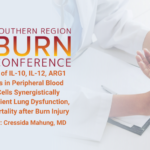Abstract | December 20, 2021
Early Expression of IL-10, IL-12, ARG1 and NOS2 Genes in Peripheral Blood Mononuclear Cells Synergistically Correlate with Patient Lung Dysfunction, Infection, and Mortality after Burn Injury
Learning Objectives
- Predict patient outcomes early after burn injury using non-invasive methods, allowing early identification of underlying immune dysfunction.
- To determine a set of peripheral biomarkers that correlates with clinical outcomes of burn patients.
Introduction:
A non-invasive evaluation of a burn patient’s underlying immune dysfunction that can predict clinical outcomes would transform burn care.
Methods:
This observational study enrolled two participant cohorts within a single Burn Center. Initial unbiased analysis compared 23 burn patients and 6 healthy controls. Confirmatory outcomes analysis was performed in 109 burn patients and 19 healthy controls. We employed multiplex gene expression analysis to identify differential peripheral blood mononuclear cells (PBMC) immune gene expression. qPCR was used to validate these findings, identify, and model associations with outcomes.
Results:
149 genes were identified with a significant difference in expression within PBMCs from burn patients compared to controls. Pathway analysis identified pathways related to IL-10 and inducible nitric oxide synthase (iNOS) signaling. qPCR analysis of IL-10, IL12, arginase-1 (ARG1), and iNOS demonstrated that burn injury was associated with increased expression of ARG1 and IL-10, and decreased expression of NOS2 and IL-12. Burn severity, acute lung injury (ALI), development of infection, failure of skin autograft, and mortality significantly correlated with expression of one or more of these genes. Ratios of IL-10/IL-12, ARG1/NOS2 and (ARG1+IL-10)/(NOS2+IL-12) transcript levels further improved the correlation with outcomes. A multivariate regression model, adjusting for confounders, demonstrated that (ARG1+IL10)/(NOS2+IL-12) significantly correlated with burn severity and development of ALI.
Conclusions:
We present a robust model to predict patient outcomes early after burn injury using non-invasive methods, allowing early identification of underlying immune dysfunction.

